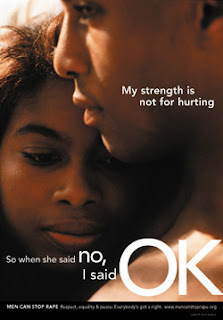In light of recent events*, it’s clearly time to move the conversation about acquaintance rape out of emergency rooms and women’s studies classrooms and into university newspapers, city council meetings, high school orientations and Pan Hellenic board meetings.
*The recent events I speak of, of course, relate to the pandemic of sexual violence executed against women since at least the beginning of recorded history (and on ANY given day...). Recent and continuing events reflect a throat-constricting reality: Women on our planet universally suffer from emotional and physical violence perpetrated against them, including a form of control and cruelty so vile even most men are ashamed to talk about it. http://www.k-state.edu/womenscenter/W.A.R/congo.html
As the advocate for victims of sexual violence here at Kansas State University, I know first-hand that students and non-students are committing the crime of rape on and around this campus, just as they are on every campus in the country. Students right here at K-State are asking women to their apartments to watch a movie, to study, to have a pizza or a drink—and then overpowering, coercing, or drugging them and violating them. There is a guy that YOU sat next to in the Union foodcourt who has GHB or Rohypnol in his pocket and he is waiting to target someone.
I answer: How does anyone protect himself or herself from violence? It permeates our society; it is often random. There are a million sexual assaults of men, women, and children in our country alone each year. The answer seems to be that we must change our campus, our community, our societal response.
Individual women have been altering their behavior--actually, giving up freedoms--trying to avoid rape for decades (or Centuries? Millennia?).
No walking alone at night,
no walking in certain places,
keep your doors and windows locked,
don't date without friends along,
don't leave a beverage unattended-- Let me ask you this: How many KSU men worry about leaving their window open on a warm, breezy summer night? A better question--how many KSU men would shut up their windows and doors on a warm, breezy, Saturday night and stay inside?
We have lists to reduce crime risk here in the Women's Center that we hand out at all our presentations. But these lists cannot begin to address the issue of why so many men use their strength to hurt and control others. No matter what women do to lower their risk of being raped, it doesn't address why our society and law enforcement and legal system and media aren't furious and up in arms over the epidemic of sexual violence.
*The recent events I speak of, of course, relate to the pandemic of sexual violence executed against women since at least the beginning of recorded history (and on ANY given day...). Recent and continuing events reflect a throat-constricting reality: Women on our planet universally suffer from emotional and physical violence perpetrated against them, including a form of control and cruelty so vile even most men are ashamed to talk about it. http://www.k-state.edu/womenscenter/W.A.R/congo.html
As the advocate for victims of sexual violence here at Kansas State University, I know first-hand that students and non-students are committing the crime of rape on and around this campus, just as they are on every campus in the country. Students right here at K-State are asking women to their apartments to watch a movie, to study, to have a pizza or a drink—and then overpowering, coercing, or drugging them and violating them. There is a guy that YOU sat next to in the Union foodcourt who has GHB or Rohypnol in his pocket and he is waiting to target someone.
(Incidentally, in 1996 the Federal Drug-Induced Rape Prevention and Punishment Act added a mandatory 20-year prison sentence for rapes where a controlled substance, like GHB, was used to incapacitate the victim. But across the culture, rape, particularly acquaintance rape and drug/alcohol-facilitated rape, is on the rise.)
People often ask, “How can women protect themselves from violence? What preventative steps can they take?"I answer: How does anyone protect himself or herself from violence? It permeates our society; it is often random. There are a million sexual assaults of men, women, and children in our country alone each year. The answer seems to be that we must change our campus, our community, our societal response.
Individual women have been altering their behavior--actually, giving up freedoms--trying to avoid rape for decades (or Centuries? Millennia?).
No walking alone at night,
no walking in certain places,
keep your doors and windows locked,
don't date without friends along,
don't leave a beverage unattended-- Let me ask you this: How many KSU men worry about leaving their window open on a warm, breezy summer night? A better question--how many KSU men would shut up their windows and doors on a warm, breezy, Saturday night and stay inside?
We have lists to reduce crime risk here in the Women's Center that we hand out at all our presentations. But these lists cannot begin to address the issue of why so many men use their strength to hurt and control others. No matter what women do to lower their risk of being raped, it doesn't address why our society and law enforcement and legal system and media aren't furious and up in arms over the epidemic of sexual violence.
see HERE
for more on this.
One of the most promising changes are the men's groups springing up all over the country, especially on campuses, as allies in the campaign for nonviolence. When men begin to challenge other men on primitive, brutal, criminal behaviors, change will come so much faster.
In the meantime,
consider these statistics:
*People of both sexes and all ages, races, abilities, positions, sexual orientation and economic status are victims of rape.
*At least 75% of rapes are committed by acquaintances of the victim, often in the victims’ own home.
*About 90% of all rapes are planned; it is a myth that rape is an uncontrollable, impulsive act of sexual gratification.
*The National Victim Center and Crime Victims Research and Treatment Center estimate that there are 1.3 rapes in the U.S. every minute.
*Between 1 out of 3 and 1 out of 7 women will be raped in her lifetime.
*FBI statistics indicate that rape is one of the fastest-growing and most underreported crimes in the nation..
At least 20% of adult women, 15% of college women, and 12% of adolescent girls have experienced some form of sexual abuse or assault.
fu'cryin' out loud.
In the meantime,
consider these statistics:
*People of both sexes and all ages, races, abilities, positions, sexual orientation and economic status are victims of rape.
*At least 75% of rapes are committed by acquaintances of the victim, often in the victims’ own home.
*About 90% of all rapes are planned; it is a myth that rape is an uncontrollable, impulsive act of sexual gratification.
*The National Victim Center and Crime Victims Research and Treatment Center estimate that there are 1.3 rapes in the U.S. every minute.
*Between 1 out of 3 and 1 out of 7 women will be raped in her lifetime.
*FBI statistics indicate that rape is one of the fastest-growing and most underreported crimes in the nation..
At least 20% of adult women, 15% of college women, and 12% of adolescent girls have experienced some form of sexual abuse or assault.
fu'cryin' out loud.







































